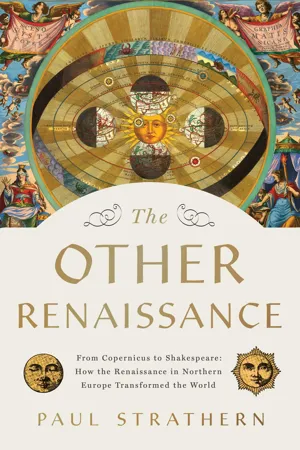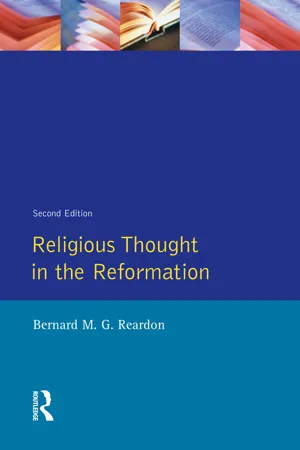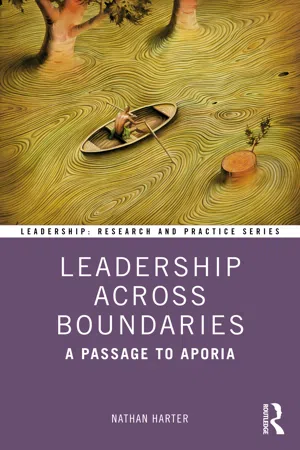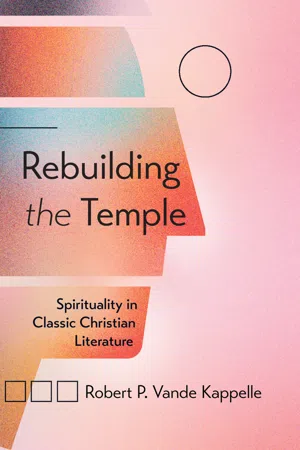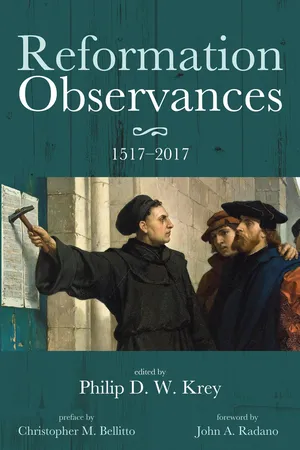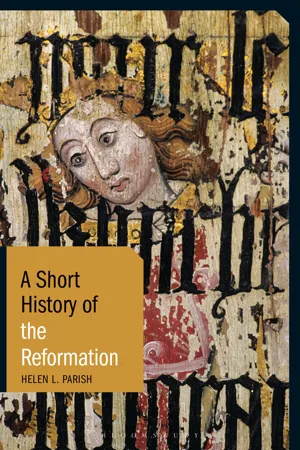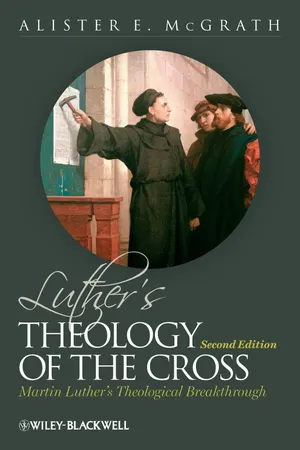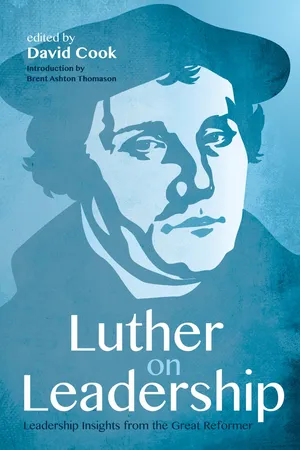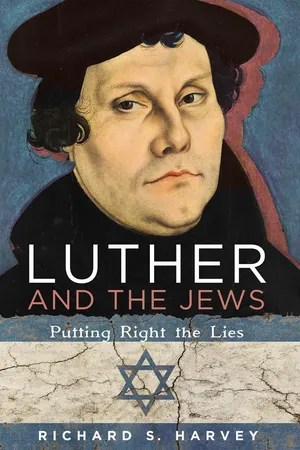History
Martin Luther
Martin Luther was a German theologian and key figure in the Protestant Reformation. He is best known for challenging the Catholic Church's practices, particularly the sale of indulgences, and for his Ninety-Five Theses. Luther's actions led to the formation of Lutheranism and had a profound impact on the religious and political landscape of Europe.
Written by Perlego with AI-assistance
Related key terms
Related key terms
1 of 4
Related key terms
1 of 3
11 Key excerpts on "Martin Luther"
- eBook - ePub
The Other Renaissance
From Copernicus to Shakespeare: How the Renaissance in Northern Europe Transformed the World
- Paul Strathern(Author)
- 2023(Publication Date)
- Pegasus Books(Publisher)
Martin Luther AND THE PROTESTANT REFORMATIONW ITH THE ADVENT OF Martin Luther, this previously imagined madness took a turn towards reality. Tradition has it that on 31 October 1517, the thirty-three-year-old Martin Luther publicly nailed his Ninety-Five Theses to the wooden door of the Castle Church of Wittenberg. Whether or not this act actually took place in quite this fashion, the symbolic force of the tale cannot be denied. This event marked the beginning of Protestantism, and an end to the hegemony of the Holy Roman Church in western Europe. The Reformation of the Church had begun.Luther’s Ninety-Five Theses was a comprehensive demand for a reform of the Church. The most significant and divisive idea deriving from the theses was his insistence that believers had direct access to God through prayer, and so had no need of intercession on their behalf through a priest. There was thus, by implication, no need for the Holy Roman Church, the pope, the priesthood, holy relics, or indeed the entire apparatus of the established Catholic religion. Luther’s act would divide Europe, plunging the entire western continent into decades of religious persecution and widespread social unrest, finally culminating in the most destructive war Europe had yet witnessed. Nothing would be the same again.This would, in effect, be the spiritual and secular conflagration which became the background to the northern Renaissance. Just as Ancient Greece had flourished through the upheavals and conflicts between its city-states – even the conquest of Athens by Sparta in the Peloponnesian War – so would the Other Renaissance take on its own distinctive cultural transformation against the background of war. In this way, the loosening of the ties binding the medieval world would enable a freedom in which the Renaissance could evolve.Martin Luther was born on 10 November 1483, the first of several brothers and sisters. His birthplace was Eisleben, a small town in a copper-mining region of eastern Germany, ruled over by the counts of Mansfeld in the name of the Holy Roman Emperor. Apart from a single visit to Rome on a pilgrimage, Luther would spend his entire life living in and around this region of Upper Saxony. - eBook - ePub
- Bernard M. G. Reardon(Author)
- 2014(Publication Date)
- Routledge(Publisher)
Chapter 3 Martin Luther: I. The Religious Revolutionary The age and the manIt has been said that ‘they who do not rightly estimate the Reformation cannot rightly understand Luther, since Luther apart from the Reformation would cease to be Luther’.1 This certainly is true, but no less true is it that apart from Luther the Reformation itself cannot be understood. He is its key figure, protagonist and spokesman alike, upon whom all others zealous for change were more or less dependent. Indeed, whether but for Luther the Reform movement of the sixteenth century would have swept over Europe in the way it did is highly questionable. What he achieved was rendered possible because the time and the milieu were matched in him by the man also, so that all the necessary elements were present to issue in events such as, in the most authentic sense, were epoch-making. That achievement was not therefore something external to him, but the utterance of the man himself and of his profound personal experience. Over the preceding century voices had repeatedly called for the reform of abuses and corruptions, but there had emerged no guiding principle on which Reformation could successfully be carried through, nor a dominant personality to give it impetus.As opinions varied so counsels differed, whereas what was needed – the outcome proved it – was the dynamism of a spiritual conviction that struck at the very heart of the evils which men of conscience yearned to see cast out. Luther it was who reached such a conviction and proclaimed it forthrightly and fearlessly. Yet to begin with it was one the full implications of which he himself did not comprehend. Only as opposition mounted did he sense the extent either of the changes that would perforce be necessary or the risks and temptations to which he, a monk and an academic, was to be exposed when thrust upon the stage of world politics. But as he was wont afterwards to declare: ‘I simply taught, preached, wrote . . . otherwise I did nothing. . . . The Word did it all.’ That, politically speaking, he could have set Europe alight, he realized, but he knew too that this was no game for him to play. For the remarkable thing is that he did not feel himself to be an autonomous agent, deploying his own resources against however powerful odds -in short, a hero challenging fate – but the instrument rather of an overriding providence and purpose. Quite apart from his talents as a man, which in any case were outstanding, Luther’s sense of mission, of doing the work to which he firmly believed, despite every doubt and difficulty that might confront him, God had called him, made him in truth a prophet; for even the soberest historian can scarcely withhold the word. Moreover, his ability to communicate verbally his overwhelming intimations of the reality of God has rarely been equalled in Christian history. In this not even St Augustine surpassed him.2 - eBook - ePub
Church History
A Crash Course for the Curious
- Christopher Catherwood(Author)
- 2007(Publication Date)
- Crossway(Publisher)
All this outraged Luther. This is why as a university professor he decided to start an academic debate on these practices. But by 1520 what had begun as a simple discussion had developed into such a major threat to the authority of the Catholic Church that Luther was excommunicated by no less than the Pope himself.Specifically Luther was protesting the sale of indulgences by a priest named Tetzel. Who was Martin Luther?Luther (1483–1546) was the son of a prosperous copper miner from Saxony, in what is now eastern Germany. Saxony was not exactly the center of the intellectual universe, although it was not a backwater either. But it was certainly outside the cultural and political mainstream of early modern Europe, and no one would have predicted that someone from there, and from what we would now call a skilled working class family, would produce the seismic spiritual revolution to which we give the name the Reformation.I have written much more about Luther elsewhere. So this, alas, will have to be a key summary of his life. Luther was originally destined to be a lawyer, and had he become one, he would have been superb at it—he argued with consummate ease—but he would also in all likelihood have been forgotten by history.But as a young man he was caught in a frightening thunderstorm. Crying out to St. Anne for help, he told God that if his life were spared he would become a monk. He survived, kept his promise, and became an Augustinian monk.He was soon lecturing at the University in Wittenberg, a new institution founded by the Elector of Saxony. He was asked to teach a series on the book of Romans, and this would change not only his own life but those of countless millions since, leading first to the Ninety-five Theses and thence to the Reformation. What he found in that epistle is best delivered in his own words. - eBook - ePub
Leadership Across Boundaries
A Passage to Aporia
- Nathan Harter(Author)
- 2020(Publication Date)
- Routledge(Publisher)
One could argue that especially in his polemical works, Luther’s apparent inconsistencies and rhetorical excesses might have served as a turbulent surface for a calm under-layer, such that they were lapses in judgment or extravagances attributable to the heat of the moment. Otherwise, perhaps there was a persisting core to his beliefs. The problem for us today is that scholars continue to quarrel over what that under-layer might have consisted of, except to the extent that it was grounded in his religious faith. Thoughtful critics are tempted to give up and say that Luther was simply not altogether coherent. He was a man of contradictions (see e.g. Pettegree, 2015, p. 283). The possibility of this finally did not seem to trouble Luther, who frequently held seemingly contradictory positions with glee, yet the turbulence and contradiction in his soul arguably mirrors the turbulence and contradiction in the world he inhabited. We are not able to shed much light today on this psychological question.Nevertheless, I am aware of nobody who would contend that Luther had no impact on his historical context. On the contrary, he has been ranked as one of the most significant figures in European history12 and certainly a founding influence on the German nation. His leadership is unquestionable, even if his thinking about leadership was never clear. As one biographer put it, “Between 1517 and 1530, Luther stood toe-to-toe with emperors and kings and contended with many of the forces that have shaped modern life” (Nestingen, 1982, p. 11). The world is different today because of him.1312 . Time magazine ranked Luther the seventeenth most influential person in human history (Skiena & Ward, 2013).13 . Febvre acknowledges that Luther was consequential, but only because of his immense failure (1929, p. 303f).In 1844, the social philosopher Karl Marx said of the Reformation in Germany that it “originated in the brain of a monk” (1978, p. 60), yet in 1852 he explained: “Men make their own history, but they do not make it just as they please; they do not make it under circumstances chosen by themselves, but under circumstances directly found, given and transmitted from the past” (1978, p. 595). In fact, he went on, “The tradition of all the dead generations weighs like a nightmare on the brain of the living” (1978, p. 595). Then Marx presents as exhibit A for this proposition the historical figure of Martin Luther, the monk in whose brain the Reformation supposedly began. As we pointed out earlier (and Marx here mentions openly), Luther was not issuing something new, so much as something quite old. Yet he did lead. He was not just a victim of his circumstances. Neither was he a puppet of his spiritual ancestors. How is that possible? - eBook - ePub
Rebuilding the Temple
Spirituality in Classic Christian Literature
- Robert P. Vande Kappelle(Author)
- 2022(Publication Date)
- Wipf and Stock(Publisher)
The four questions that Protestantism answers in new ways are: (1) How is a person saved? (2) Where does religious authority lie? (3) What is the church? and (4) What is the essence of Christian living? During the sixteenth century, Protestant Reformers agreed on the essentials, but fresh answers emerged in Martin Luther’s conflict with Rome. The Protestant Reformation brought profound changes to European culture, for the Reformers repudiated the synthesis mentality that had dominated Christian thought for centuries. Many secular historians have argued that political, economic, and social issues inspired the major transformations of the sixteenth century. While these forces influenced the development and course of the Reformation, spiritual and moral issues were primary. Above all else, the Reformers sought to correct the doctrine and life of the church. Their movement represented “a revolt of conscience.” Two major worldviews molded medieval intellectual and religious culture: the Greek and the biblical traditions. The Reformers sought to repudiate medieval thought, with its reliance upon reason. In their opinion, medieval thinkers had made a conscious and thoroughgoing attempt to fuse radically different traditions into one theological system. The Reformers’ attack upon extravagances of the papal court, the sale of indulgences and church offices, and excessive church taxation were part of a larger campaign to return the church to its biblical foundation. Their cry became ad fontes, “back to the sources,” meaning that they wished to return to the scriptures of the Old and New Testaments. Martin Luther: Biographical Considerations The son of a peasant miner, Martin Luther (1483 – 1546) had every intention of becoming a lawyer until one day in 1505 he was caught in a thunderstorm. Struck by a bolt of lightning, he prayed to the patroness of miners, “St. Anne, save me, and I’ll become a monk.” He kept his vow and two weeks later entered an Augustinian monastery - eBook - ePub
- Krey(Author)
- 2017(Publication Date)
- Cascade Books(Publisher)
th Anniversary Celebration of the Reformation will observe him more as the common doctor of the church than hero and prophet.We know that Luther’s critique of scholastic theology and his theological concerns with indulgences began earlier than the evening and the day of All Saint’s (October 31 –November 1 ) 1517 , but this weekend has been etched into the historical imagination over the centuries that this essay will address. Scholars have proposed that Martin Luther’s reform can now be understood as the most significant in a series of medieval and late-medieval attempts at reform.6 In some sense the Roman Catholic Church had become immune to the many attempts at reform from, for example, the Mendicant movements of the thirteenth century that were received by Pope Innocent III to the failed reforms of the Conciliar movement of the fifteenth century that foundered on the reefs of nationalism and a timeless attraction for a strong leader over against a constitutional and balanced papal monarchy. In any event, in the sixteenth century the context left Luther, the Augustinian monk and young professor of theology at the University of Wittenberg, with a proposal for reform and a number of secret sympathizers but a hardened church structure that made dialog impossible.7 He was eventually declared a heretic.8What happened on that critical day?9 The Augustinian monk and young professor at the University of Wittenberg (age 34 ), Dr. Martin Luther sent a letter to the Archbishop of Magdeburg–Mainz alerting him of the danger to the proclamation of the Gospel in his territory since the Dominican Friar Johann Tezel was marketing and exaggerating the sale of indulgences. To this letter Luther attached theses arguing theologically against the sale of indulgences.10 He did not expect the Prince-Bishop to respond to the theses, as the disputation was the right and duty of the university.11 Thus Luther was working on this issue for some time. The Wittenberg faculty including Andreas Karlstadt was preparing for theological debate.12 Luther had been researching the ecclesiastical, theological, and legal grounds for indulgences earlier in 1517 and was distressed by the great collection of relics that Prince Frederick had stored at the Castle Church—the list of which would be read publicly on All Saints Day, November 1 . Historians agree that whether or not the Theses were posted, the events of the days lose none of their historical importance.13 To some extent Luther was surprised by the broad reception that the Theses received. That the subsequent sermon “On Indulgences and Grace” (Feb. 2 , 1518 ) in German enjoyed at least twenty editions surprised Luther.14 What was and remains decisive is the Reformation’s proposal to the church catholic, a proclamation of the gospel that continues to challenge and influence Lutheran, Reformed, and Roman Catholic Christians to this day.15 - eBook - ePub
- Helen L. Parish(Author)
- 2018(Publication Date)
- I.B. Tauris(Publisher)
Rather, debates over Reformation theology are to be found in works of history and literary studies, cultural and social analyses of the age of reform. Theological principles did not arise in a vacuum, but grew out of the broader environments into which they were planted. The discussion of theology therefore requires a similar willingness on the part of the scholar to reflect upon that context and to seek out the practical impulses that acted as a catalyst or a brake on doctrinal change. Salvation was a practical, rather than abstract, theoretical concern, and the question of how to secure the fate of one’s eternal soul mattered across the broadest demography. The theologians of the Reformation were themselves its pastors and preachers, and our ability to access their ideas and ambitions derives from a reading of the means by which they were communicated: sermons, polemical treatises, letters of support and exhortation. 3 THE START OF THE REFORMATION?: 31 OCTOBER 1517 In February 2015, the toy manufacturer Playmobil announced that its figurine of Martin Luther was the fastest-selling model in its range. Within 72 hours of its release, some 34,000 figures of Luther, complete with hat, quill and German Bible, had been sold. 4 A spokesman for the company conceded that the popularity of the Luther figurine had come as something of a surprise, attributing the rapid sales, primarily in Germany, to a growing interest in history and the desire of parents to ensure that their children grow up with an understanding of how ‘a totally normal person [who] shared the belief of the majority of the people of the time’ could still speak to a twenty-first-century audience. The mass production and consumption of the Playmobil Luther pays homage to the traditional legend and imagery of the origins of the Reformation. Luther, in this story, articulated his grievances against the Roman Catholic Church by hammering his 95 Theses to the door of the castle church in Wittenberg - eBook - ePub
Luther's Theology of the Cross
Martin Luther's Theological Breakthrough
- Alister E. McGrath(Author)
- 2011(Publication Date)
- Wiley-Blackwell(Publisher)
Part OneThe Background Luther as a Late Medieval Theologian, 1509–1514Passage contains an image Chapter 1 The Dawn of the Reformation at Wittenberg
Our story concerns the intellectual and spiritual development of Martin Luther (1483–1546) during the years 1509–1519 – particularly 1512–1519, which many regard as being a decisive phase in this process. During these critical years, Luther began to inch his way toward his own distinctive understanding of how sinners are able to enter into the presence of a righteous God, classically expressed in the doctrine of justification by faith. While the relationship between the emergence of Luther's theological distinctives and the historical origins of the Reformation as a whole is somewhat more complex than some popular accounts suggest,1 there is little doubt that Luther's theological breakthrough was one of a number of factors that proved to be of decisive importance in catalyzing the massive social, economic, political, and religious transformations of the Protestant Reformation.2This study sets out to analyze the emergence of Luther's understanding of the question of how humanity is justified in the sight of God, focusing especially on his shifting views concerning what it means to speak of God as “righteous.” How can a sinner hope to find acceptance in the sight of a righteous God? Wie kriege ich einen gnädigen Gott? Luther's changing answers to that central question set the scene for the great upheavals of the Reformation.3Yet a second distinctive feature of Luther's early thought emerges alongside these reflections on the nature of divine righteousness, and how a righteous God could accept and love sinful humanity. Luther's celebrated “theology of the cross” is the outcome of the same process of reflection that led Luther to his doctrine of justification. The two themes are intertwined in his early writings, and can in some ways be seen as two sides of a single, related question – namely, how humanity is to live by faith in the shadowlands of sin and doubt. We shall consider both these major theological themes in this study. - eBook - ePub
Luther on Leadership
Leadership Insights from the Great Reformer
- Cook(Author)
- 2017(Publication Date)
- Wipf and Stock(Publisher)
But what made Luther unique was that he combined this intellectual base with a strong practical push for change. While many other great theologians down the ages have made radical claims which could have shaken their societies, Luther stands apart as a leader who not only challenged the status quo, but helped lay the foundation for a new status quo. His vociferous attacks on the corruption within the Catholic Church coupled with his unique theological arguments convinced many in society that they should reject the old way of doing things. But in turning from Catholic norms, these followers of Luther were left with a void in many areas of their cultural milieu. In response, Luther and his colleagues took an active part in helping to reconstruct society in a way that comported with their comprehensive biblical worldview. From drafting model laws, to writing influential treatises, and preaching about practical cultural issues, Luther stepped into the foray and tried to help the German people and their leaders re-craft society in a way that he felt would be pleasing to God. 102 Along with Luther, colleagues such as Philip Melanchthon, Johannes Bugenhagen, Johannes Brenz, Johannes Eisermann, Johann Oldendorp, and Martin Bucer played important roles in shaping the laws of dozens of cities, provinces, and territories in and around Germany. 103 The practical measures they took to help reform society had broad impacts in many areas. Thus, the next few sections of this chapter will focus on these practical impacts on the political, legal, educational, and economic systems in the West. Politics The practical effects of Luther’s theology and actions hit at the core of the political framework for much of Western society. As noted above, Luther’s attacks on papal authority, when combined with his theological doctrines of priesthood of the believer, the three estates of society, and the two kingdoms of the world, shook the foundations of political thought in Protestant territories - eBook - ePub
Luther and the Jews
Putting Right the Lies
- Harvey(Author)
- 2017(Publication Date)
- Cascade Books(Publisher)
200,000 . Luther himself did not like the term “Lutheran,” preferring to call himself and others who affirmed the gospel “evangelical.” Today this term has different meanings in different contexts, but for Luther it meant those who stood by the good news of Jesus Christ, and recognized the need for Reformation in the church.Luther did not intend to form a new church or denomination, but rather to remain within the “one, holy, catholic, and apostolic church” (the four marks of the church, according to the Nicene Creed). His followers, and those of the other Reformers—John Calvin and Huldrych Zwingli in Switzerland, Thomas Cranmer in England, John Knox in Scotland, and many others—wanted to restore a biblical foundation to the church based on the three solas: sola Scriptura , sola gratia , sola fide (“by Scripture alone, by grace alone, by faith alone”).Following the death of Luther in 1546 , there were three main developments over the centuries, which we need to know about in order to understand his legacy today. These were Protestant Orthodoxy/Scholasticism (sixteenth to seventeenth centuries), Enlightenment Rationalism (eighteenth to nineteenth centuries) and Pietism (eighteenth to nineteenth centuries).Like the Scholastics (“school men”) of the Middle Ages in the Roman Catholic Church, such as Thomas Aquinas, who focused his energies on discussion of the philosophical nature of Christianity, the Protestant Scholastics focused on correctly interpreting Luther’s theology. The focus shifted from the experience of salvation by grace through faith to deciding what correct doctrine was, and this meant understanding the relationship between law and grace, and the place of good works. Melanchthon, Luther’s colleague and disciple, mediated between conflicting views, and decided that although good works were not necessary to earn salvation, they were still necessary in the life of a believer. - eBook - ePub
Western Civilization: A Global and Comparative Approach
Volume I: To 1715
- Kenneth L. Campbell(Author)
- 2014(Publication Date)
- Routledge(Publisher)
Not all Old Believers were superstitious fanatics blindly adhering to past traditions. They continued to provide an alternative approach to spirituality than that offered by the dominant clerical and political elite. Conclusion The religious reformation that began in Europe in the sixteenth century can be considered one of the most significant events that shaped world religious history. The Reformation was a series of movements that differed significantly from each other, but, when taken together, resulted in the sudden and rapid polarization of the monolithic Christian church into two distinct groups–the Roman Catholic and the Protestant. But Protestant and Catholic political leaders shared some important commonalities. For all their differences, Protestants and Catholics still worshipped the same God, regarded the Bible as their primary religious source, held the same conception of fallen humanity contaminated by original sin and needing the intercession of Christ as redeemer, and believed in the competing forces of good and evil in the world. These beliefs manifested themselves in the sixteenth and seventeenth centuries in the European-wide persecution of people believed to be witches in league with the devil (see Chapter 4 in Volume II). Both Catholics and Protestants relied heavily on logic and rational argument to defend their positions, regarding God as a being whose existence could be proved and demonstrated. Many Catholics and Protestants believed that two religions could not coexist within the same state, although in practice Catholics and Protestants in a number of local communities across Europe found a way to do just that. Both Catholic and Protestant rulers regarded religious uniformity as a prerequisite for political loyalty. Both persecuted religious minorities and feared countries with a different religion as real or potential enemies
Index pages curate the most relevant extracts from our library of academic textbooks. They’ve been created using an in-house natural language model (NLM), each adding context and meaning to key research topics.
Explore more topic indexes
Explore more topic indexes
1 of 6
Explore more topic indexes
1 of 4
